In February 2015, I took a 12-day trip to Costa Rica (my first real vacation!) Part of the reason I decided on Costa Rica was that this culture is well-known for emphasizing sustainability in a way that is well beyond lip service, and I wanted to experience it for myself and see what I could learn while I was there. I want to touch on the many things I observed and learned on this journey with regard to sustainable living and permaculture design. I traveled to four areas and drove across large portions of the countryside: the Monteverde region (high in the cloud forests), the urban and suburban San Jose region; the volcanic La Fortuna region, and the coastal Manuel Antonio region. One thing to remember about the Costa Ricans–they are one of the happiest countries in the world. I don’t think this is a fluke–I think it’s directly tied to the ways in which they live sustainably, have protected and preserved their own landscapes and local economies. So I’m going to look at some of those ways, envisioning Costa Rica as an alternative model for living. Along the way, I’m going to discuss permaculture design from its three ethical principles: Care for people, Care for the Earth, and Set Limits/Redistribute Surplus.
Localized Economies
I want to start with the economy because A) it’s the sacred cow of US politics and really the only thing anyone talks about these days, but also B) Costa Rica shows that there are viable alternatives for localized systems of wealth that empower people and protect the land. One of the most amazing things about Costa Rica was the localized economy–and how this manifested in the landscape. Literally everywhere we went, towns, stores, and businesses were different. They had different stores, small businesses, different kinds of food, artist-owned co-ops, wonky weird places and much more. In the USA, we are literally drowning in Walmarts, McDonalds, Rite Aids, TGI Fridays, Holiday Inn, Chase Bank, Subway, TJ Max, etc. Each town is a replica of the previous town, with the same 40 or so corporations promoting their wares. It’s like a rubber stamp; town after town looks the same. Each has this long line of strip malls with bad traffic and noise pollution, and you are supposed to WANT to go there and shop and purchase the same industrialized food. Occasionally, a town or city will try to break out of it and have a “weird” core that is locally owned and unique (I think about Austin, TX, or Ann Arbor, MI) but even with their weirdness, the mega-corporations are still there, just around the corner. I never realized how bad this was until I went to Costa Rica and drove all around the countryside.
In Costa Rica, the businesses are generally all locally owned, unique, and charming. I stayed in small B&B’s, farms, and small hostels everywhere and they were operated by the people who owned them and employed local workers (chain hotels weren’t even an option most places I stayed). A lot of these places were farms or sustainable living centers that also offered a bed to weary travelers. The accommodations were simple and wonderful. I ate food made and grown by locals (you didn’t even have to ask where it came from–you could just taste that it was fresh), I bought local art, and enjoyed locally-based attractions (like an orchid garden with 2000+ orchids or a sustainable chocolate plantation). It was amazing because everything was different, and unique. Many places also embraced the landscape–they had gardens, walking paths, big trees, and the business “flowed” with the landscape so much more. And it was economically successful.

This really gets at the permaculture design principle “Care for People.” People are empowered–they can own businesses, hire each other, and determine their own economic realities. I think they are rooted in their communities, they also care more about what happens in them (than say, Walmart, who really couldn’t give a damn about the local town or their local workers they are in because their economic reality isn’t firmly rooted there). And when the people are cared for, they can focus on caring for other things, like the land and each other.
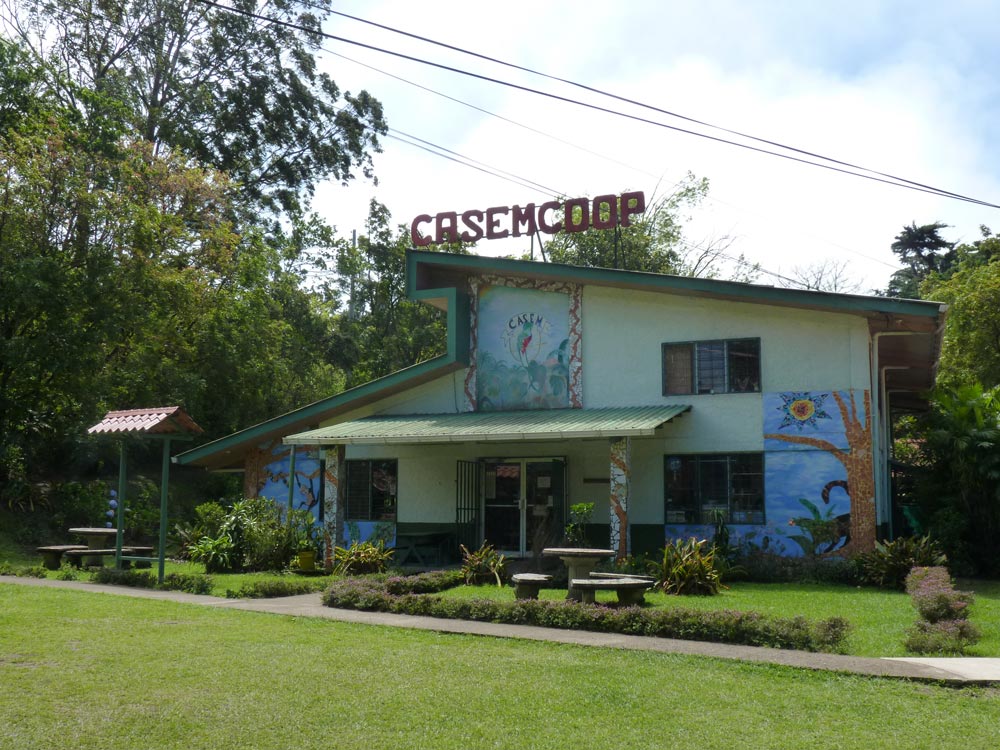
Housing.
By American standards, most Costa Ricans live in, as one snarky American I met on my travels called them “shacks.” The houses have metal roofs, outdoor living areas, and rather small interiors. I would say that the Costa Ricans live simply, and there is much to like about how they live. Because really– how much space does one person need? We have large houses here in the states to accommodate the “stuff” that we purchase and store as part of consumerist culture. But simple living, with fewer and more meaningful things, has a lot going for it, as the Costa Ricans demonstrate. The only American-sized houses that I saw were owned in areas where Americans lived–the signs were in English, the lawns were present, and the houses were enormous in those resort areas. But everyday life in Costa Rica doesn’t look like that–typical dwellings are probably about 800 or so square feet, on dirt roads, colorfully painted, gated, with clothes hanging outside and goats in the front yard. I think this really gets at both the “Care for people” and “Care for earth” permaculture ethical principles: the houses are small, they are integrated into the landscape, but people don’t take or have more than they need, so the earth is cared for at the same time.
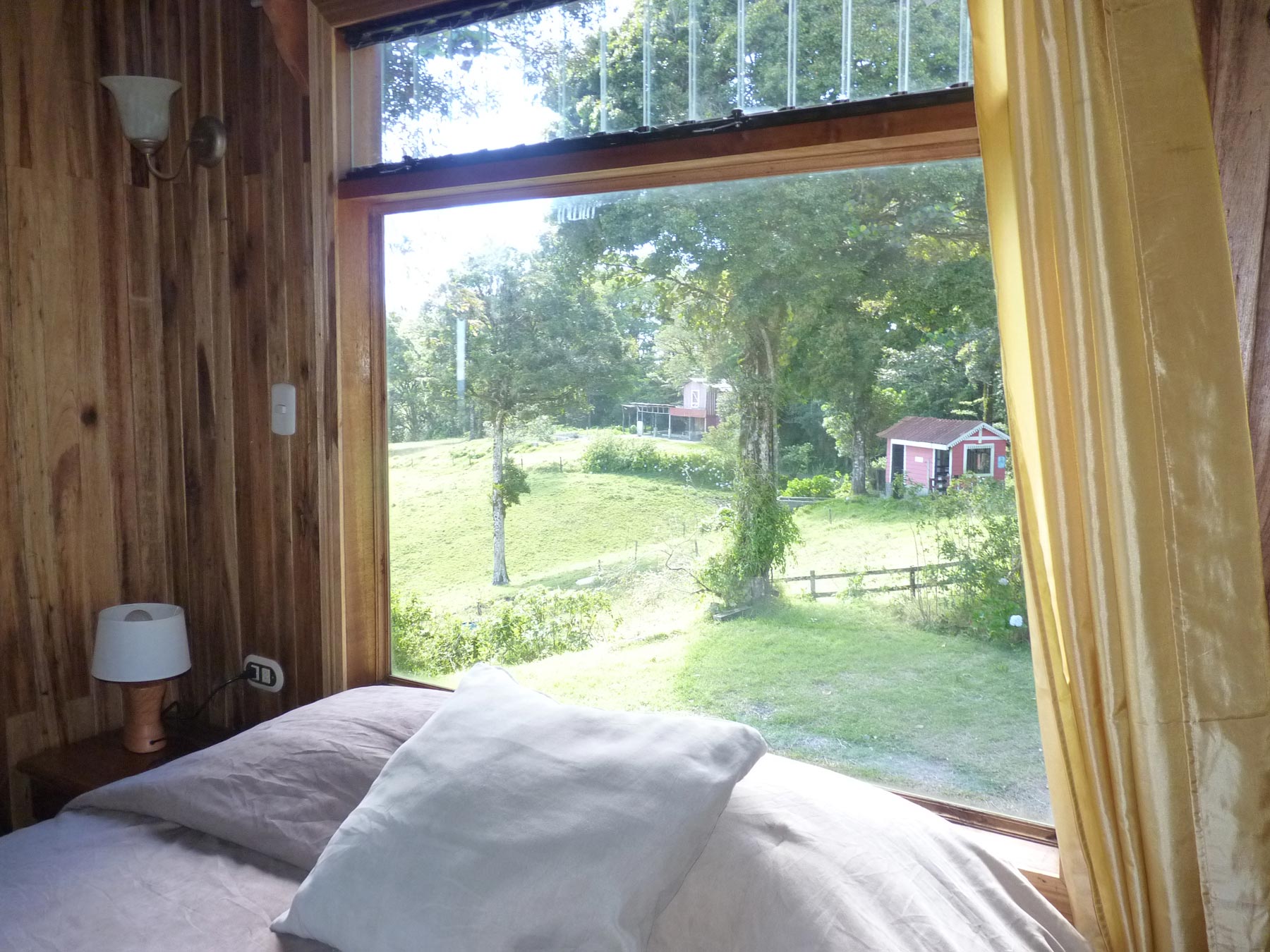
It also “sets limits” to the size of the habitation, and the amount of space one takes up in the world–and I think these are very, very good things.
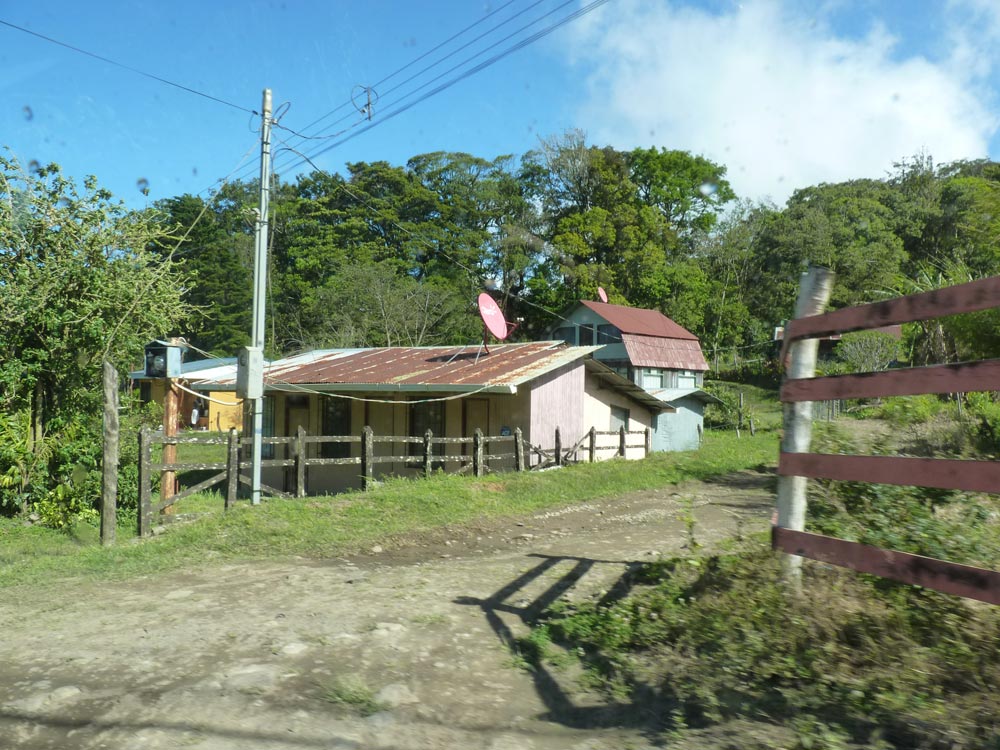
Lawns & Everyday Interactions with the Land
Typical Costa Rican homes, at least in the areas that I stayed in and drove through, did not usually have lawns. If there were grassy areas (such as outside of the front of my bungalow at the sustainable ranch where we stayed), the grass that was planted sometimes was a variety that did not grow more than a few inches high and did not require mowing. That grass was mixed with other low-growing plants including plantain (so nice to see my plant ally there!) and some sort of violet. But other homes’ lawns were pastures–and the cows would occasionally be let out to “mow” the front of the pasture near the road. What I like so much about the “lawn as pasture” idea is that it redistributes the surplus–green growth–into cattle and horses, which can then be utilized in various ways (for food, transportation, milk, and companionship).
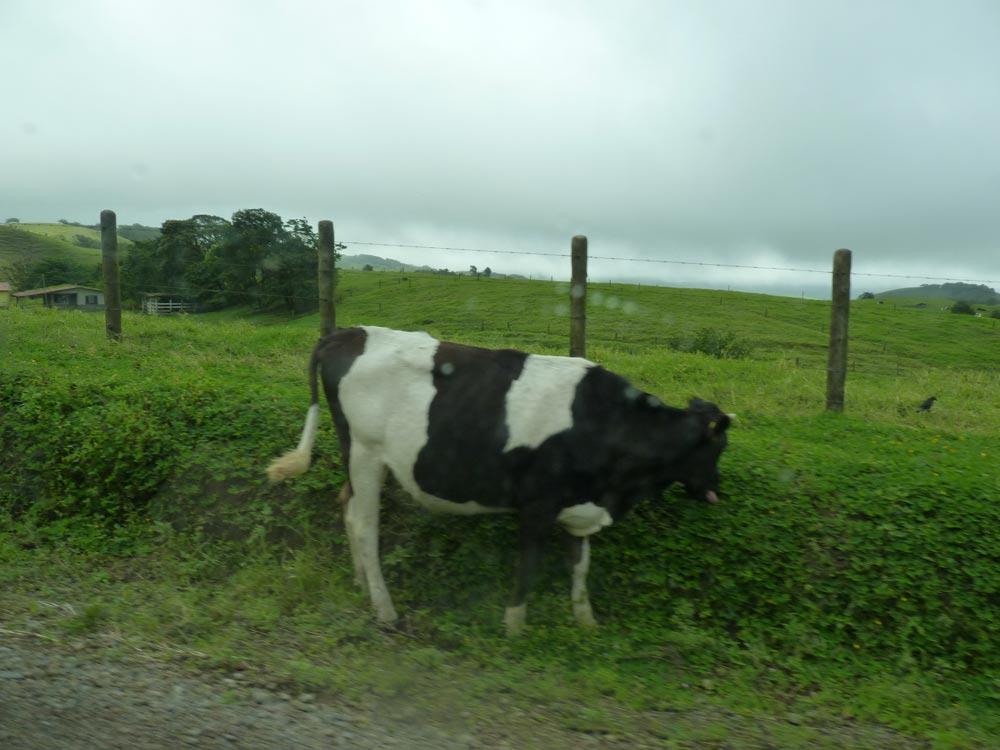
Many homes had food forests in their yards–banana trees, mangoes, coconut palms, and various veggies like corn, lettuce, kale, and tomatoes. Nearly everyone was growing something, and most had quite a lot. In the areas closest to the road, sometimes long grasses grew. I saw them employ three techniques to handle this–on some steep hillsides, I saw a few instances of men with weed whackers, I also saw most that people would bring in cattle or horses to graze grassy areas as I already mentioned; finally, some employed controlled burning. The only kinds of houses that had lawns were the homes that appeared to be much larger and much more wealthy–larger homes emulated American lawns and American sizes (and, where I saw the most, around the Arenal Lake’s northeastern side, the land was clearly being purchased by and catered to Americans).
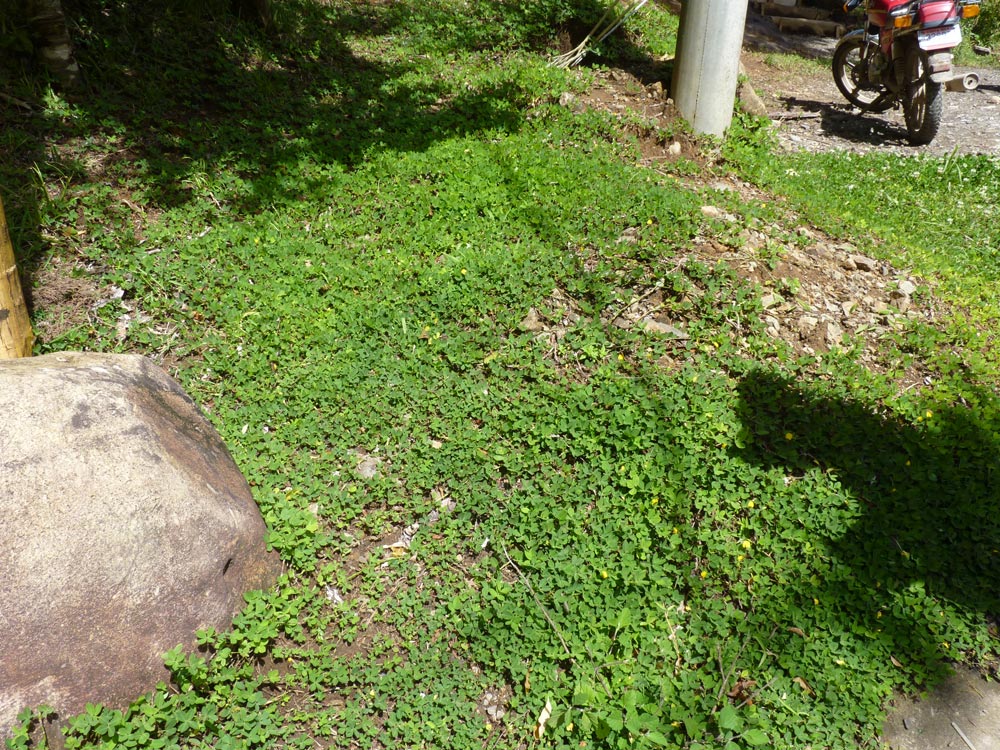
Livestock.
Costa Ricans keep a lot of livestock–a type of cow that does well on the very hilly pastures. Many also kept horses and used them for transportation. This is true whether you live in the middle of San Jose or out in the middle of nowhere–everywhere livestock is legal and everywhere people have chickens, cows, goats, sheep, pigs, and horses.
We stayed on a small family farm in the Monteverde region that was a working ranch; they had various kinds of cattle and horses. They also kept pigs as “biodigestors” for compost and kept chickens for eggs. We were able to observe and take part in ranching and farming activities while we were there, such as seeing the greenhouses, feeding the chickens, walk the fields and pastures. The buildings were simple and functional; the land rich, green, and well-tended. As was the case with earlier times in the history of the US everyone seemed to keep some kind of animal, even in the middle of the city you could hear the roosters crowing up the morning sun. The ranch was great because they had intentionally designed it to care for people (human and domestic animal habitations), care for the earth (half the ranch was forest and wild areas, with walking paths or just fully wild) and to redistribute surplus through composting and other techniques.
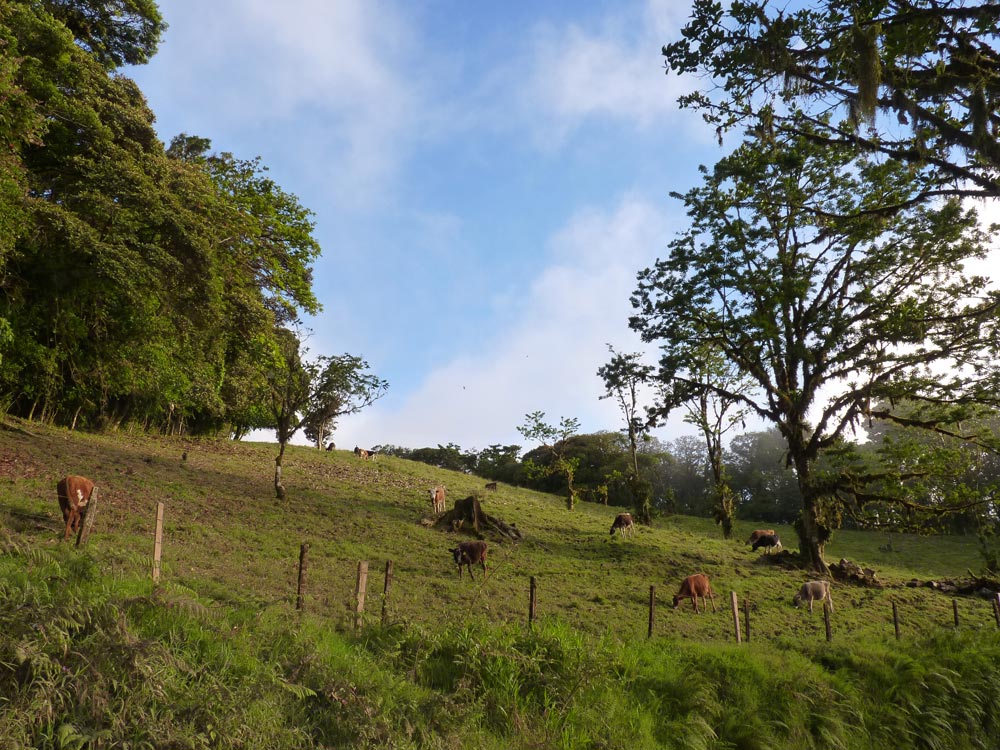
Farms and Gardens.
We visited many gardens and farms while in Costa Rica–they were quite easy to find and very abundant. I will be writing about two of them in upcoming blog posts. Many of them advertised their sustainable activities right on their signs, being “carbon neutral” or “100% organic” or “sustainable farm.” But this wasn’t mere talk–Costa Ricans live sustainably, care deeply about the environment, and really mean what they say. In a nutshell, we saw all of the techniques for sustainable organic farming being enacted everywhere we turned: no chemicals or big sprayers, rainwater harvesting, composting, bioferments, perennial crops, effective soil management, integrating livestock, vermicompost, trap crops, terracing, reusing materials, using principles of permaculture design, closed-loop systems, and more ( The one exception to this was the palm oil farms–and I’ll talk about those in another post.) These sustainable, organic, bio-intensive farms are doing it right–in small spaces, they are caring for the land, the earth, and redistributing surplus back into the landscape. I’ll also note that Costa Rica banned all GMOs in their country as of January 2015. This is a major victory!
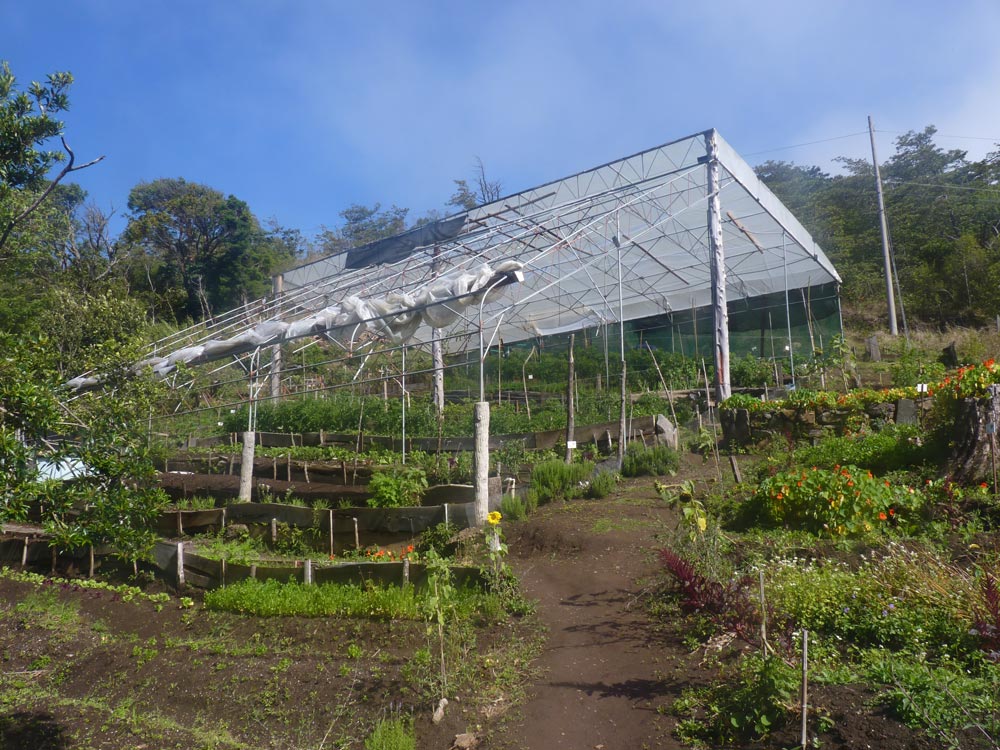
Handling Waste.
You know you are in a place that values sustainability when its harder to find a trash can over a recycling bin, and when recycling bins look like this. Note that there IS no trash can here–and these were the options you had available to you. Talk about redistributing surplus and setting limits!
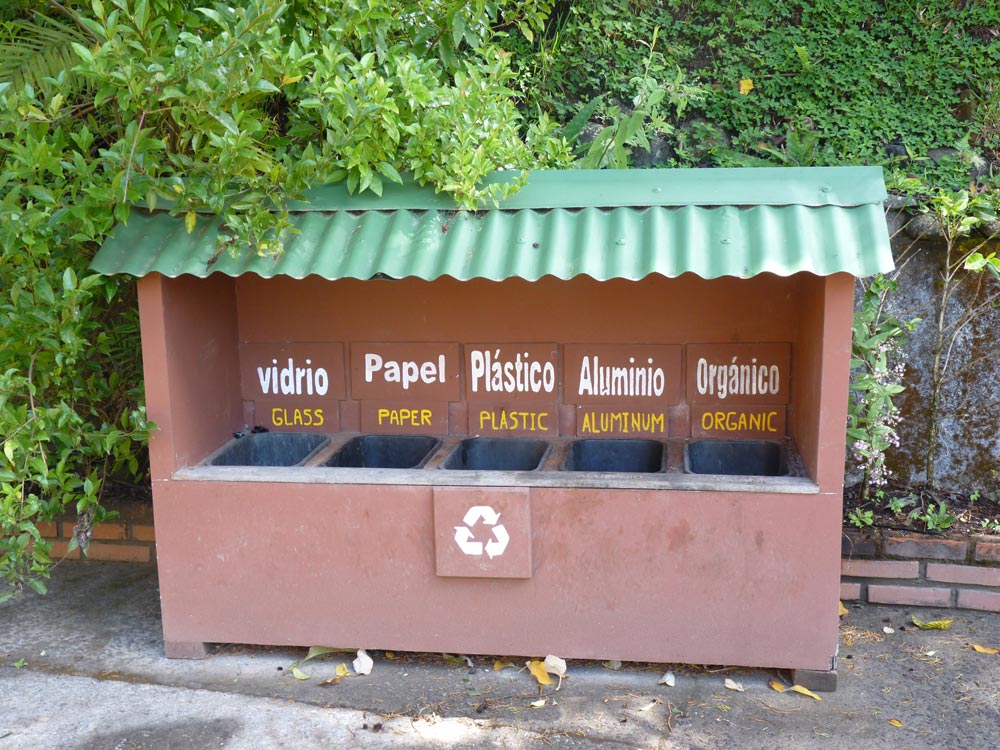
Local Food.
Costa Rican fare was simple, local, and delicious. The “typical” Costa Rican plate had a generous portion of rice and beans, sweet fried plantains, a meat/fish/avocado and cheese main portion, steamed vegetables, and a salad. All of this food was locally grown (except the rice, as far as I could tell). Everywhere we went, food was being fed to us right out of the farms, everyone kept livestock, the eggs were fresh off the farm, etc. Here, it’s nearly impossible to eat like this every single day if you aren’t growing it yourself–you can’t figure out where the food comes from and it takes considerable effort to source all local ingredients. In Costa Rica, I ate organic, wholesome, delicious food every single day. We saw very little in the way of fast food, especially any kind of fast food chain, although they still were present, especially in the city, where McDonalds and KFC are trying to weasel their way in. One day, I went white water rafting, and was told that “lunch was included.” In the States, this would be some sandwiches, industrialized food for sure. In Costa Rica, they took us to an organic farm and we had the most amazing meal, a farm-to-plate meal complete with locally grown coffee, fresh sugarcane juice, and amazing vegetables. Here it was:
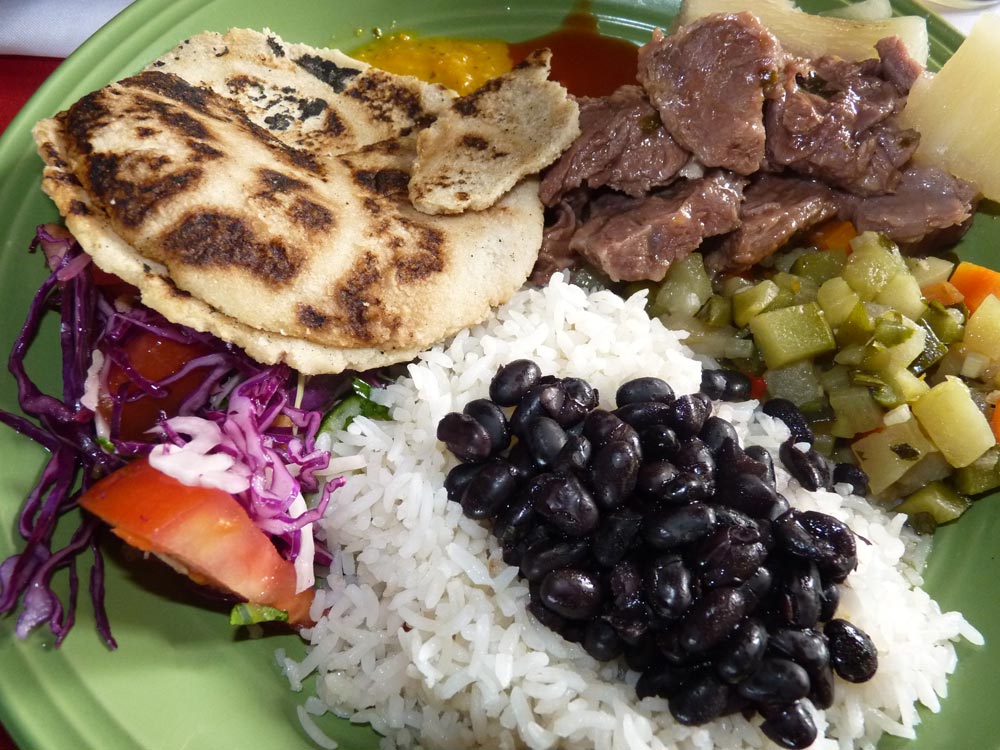
Transportation.
As I mentioned before, horses are in wide use in Costa Rica as a means of travel. The public transportation system, even in the most remote areas, is quite good–there are bus stops on nearly every major road and many are using the bus system. One can travel most of the way across the country on a bus for less than $50. Many also use small, fuel-efficient motorcycles. Gas is about $5/gallon, so that alone makes people purchase and employ fuel efficiency. I witnessed more than one electric scooter, in addition to the bicycles and plain old walking, which Costa Ricans do a lot. This demonstrates a lot with regards to “care for the earth” and “setting limits.”
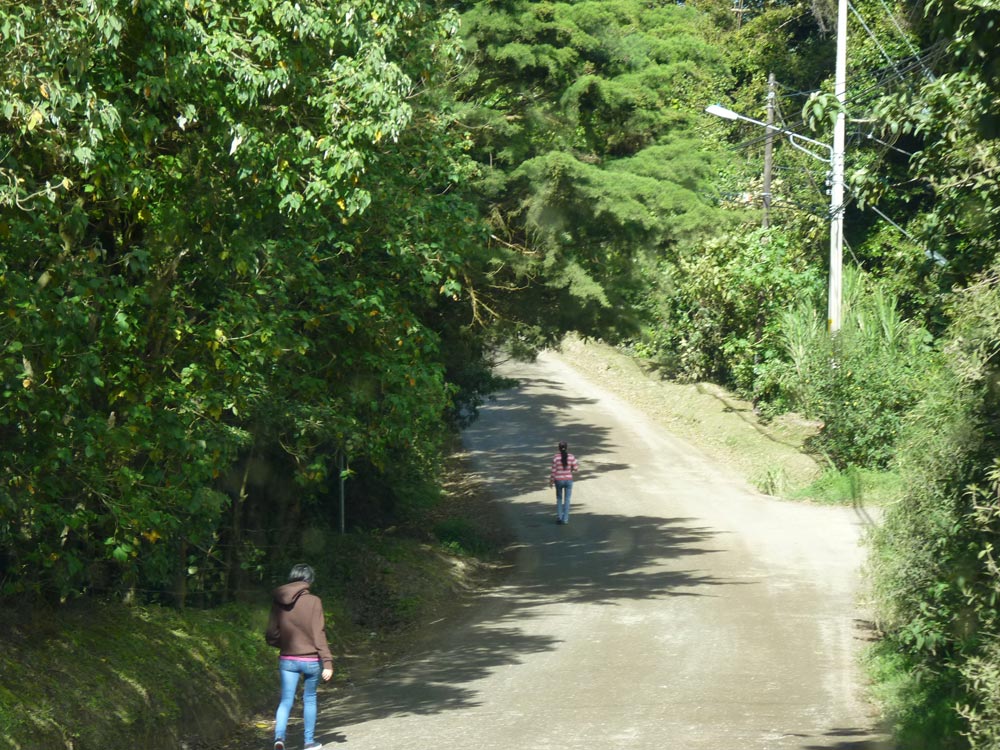
Respecting the arts.
Beautiful, colorful Costa Rican art, was abundant everywhere we went–from the streets of San Jose to the smallest town and village. The art was nature-themed, vibrant, and full of positive energy–not full of the ennui of modern life, but that which reflects the surroundings. Much working of wood, stone, inspired by nature. And it’s valued—and everywhere! I will be writing more on the value of local art and local artists and how that enriches a culture at some point in the coming months!
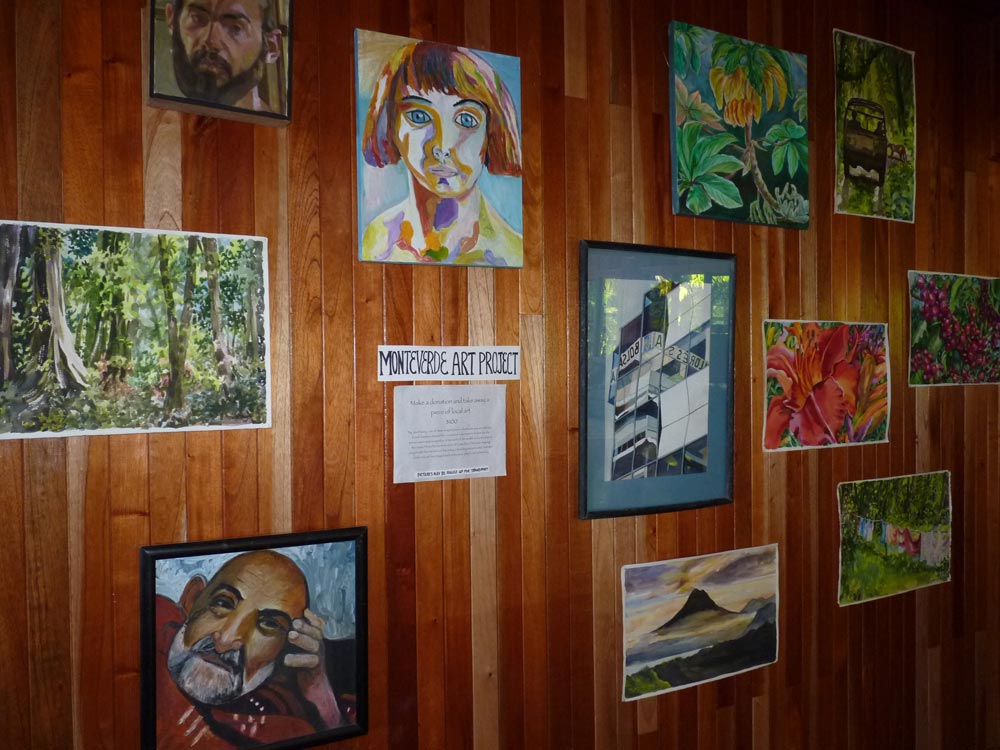
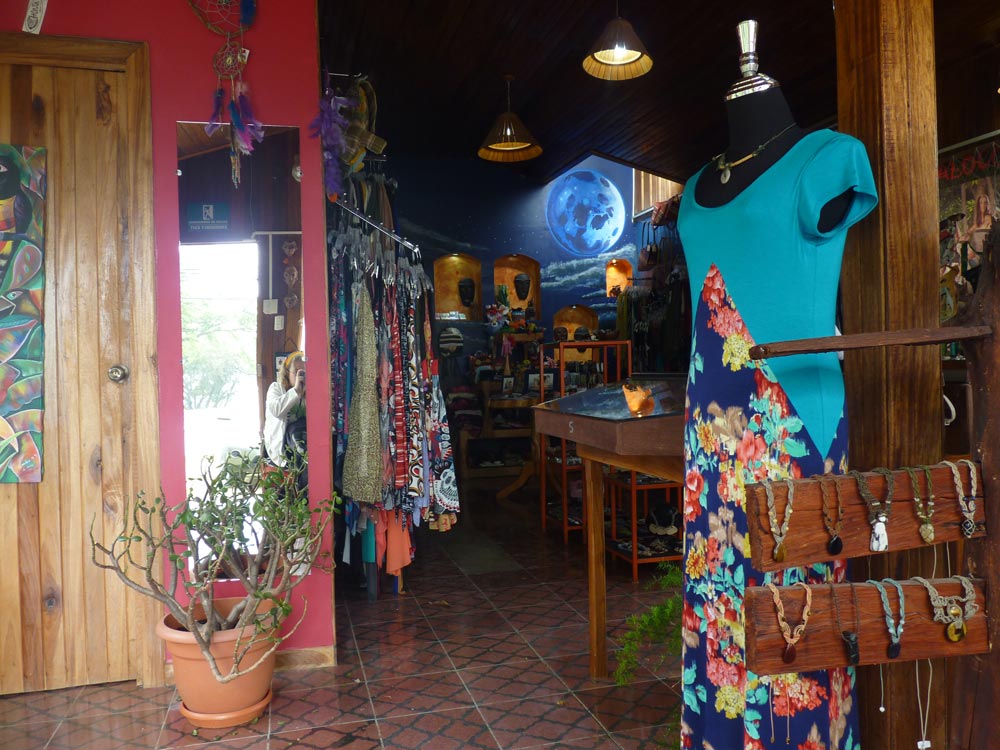
General Happiness.
Costa Rica is, by multiple measures, one of the happiest nations in the world. Some would say that this is because they are a tropical paradise–but I point to other countries in Central America, like Mexico or Honduras, which do not measure anywhere near the happiness levels.
I think this is not only the result of much of what I’m describing in this post, but also because of a few other cultural things. First, because the Costa Ricans seem to be moving at a different speed. There is siesta, a two-hour nap/rest/break in the middle of the workday. There is a general and deliberate taking of one’s time, especially in the areas outside of the big city. WE all stop and watch as a man herds his cattle down the road–nothing to do but enjoy the experience. Its not assumed that we eat and run, rather, that we should savor the meal–the bill is only brought AFTER we ask. These are values in many Latin American countries and families–and to my mind, certainly better than the insane/mad dash/race to nowhere that comprises so much of the modern American lifestyle.

Another reason that I think Costa Ricans are so happy has to do with some cultural values, specifically, a collective rather individualistic mindset. A while ago on this blog, I talked about individualism vs. collectivism as mindsets (based on the work of sociologist Geert Hosfede* ; whose work you can look at here). Costa Ricans care about each other and about the group much more than Americans–they have a collectivist mindset (this is that they think in terms of “we” rather than “I”). On Hofstede’s scale, the US manifests at a 91 for individualism (which is extremely high) and the Costa Ricans have a 15, which is very low. I suspect, although I haven’t yet researched this theory, that issues of collectivism also relate to environmental protection, because a collectivist culture who sees their land as inherently one with themselves will extend it the same protections they extend their families and cultures. This thinking was apparent in many of the conversations I had with Costa Ricans about their interaction with the land.
Another reason is just the general laid-back nature of life in Costa Rica. The society lacks the extremely restrictive laws and codes on buildings, lawns, other outdoor spaces, and vehicles and so on. Costa Rican life is extremely laid back and friendly, and their much less restrictive laws demonstrate that. When I think about laws in the US, we have all these laws in place not to benefit the people, but to keep us engaging in certain consumptive behaviors or living in certain kinds of structures or having our property look certain kinds of ways because someone profits from it. In other words, the laws are mostly written these days to benefit some corporate stakeholders, not the people. We live with the laws and think they are necessities of life–but they are not, and the Costa Ricans clearly get on fine without them.
A final reason has to do with how monetary wealth (which I specify from other kinds of wealth, such as rich living or healthy food) is wrapped up into the economics of place. The US is considered to be a very wealthy nation–we are a nation of consumers and stuff–but that stuff isn’t rooted, isn’t connected to place. The problem is, the more stuff we have, the less happy we are and the more restrictions we have. Simple living, fewer laws, less stuff, better food, localized economies, love of the land…these are all features that make Costa Rica great.
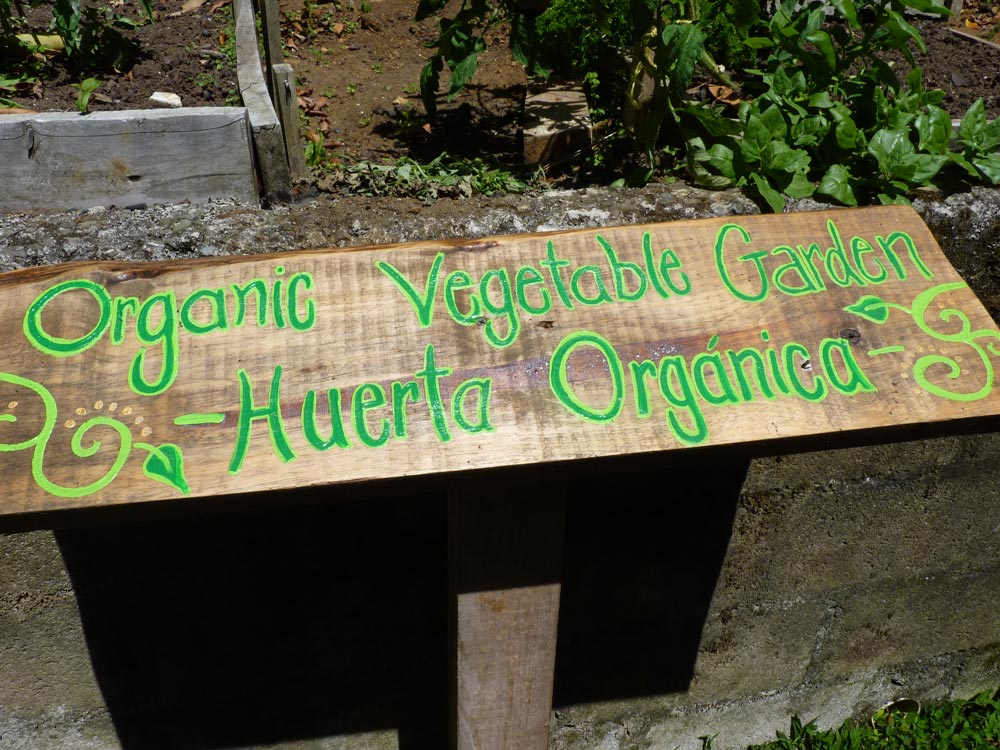
General Thoughts.
While Costa Rica is far from perfect, I do think we have a lot to learn from them in terms of sustainable living and seeking happiness. I had a very hard time “readjusting” to life in the USA after being in Costa Rica. After seeing firsthand how different and more aligned with my own value system life could be, it was hard to come back. It was hard to come back to watching people consume poisons, chemicals, and modified foods, to watch them drug their children on ADHD medication, to do battle on the roads on my way to work each day, to just look at how despondent, run-down, and miserable everyone is (pay attention next time you enter a grocery store), and to watch people spend much of their lives attached to various screens.
But this trip has given me a sense of renewed hope. Costa Rica, with its sustainable principles undercurrents so much of life, is thriving. This kind of living can work, and perhaps, they can serve as a model to many of us who are transitioning ourselves and our communities into something simpler, locally-focused, and more fulfilling. The question is…how can we build it?
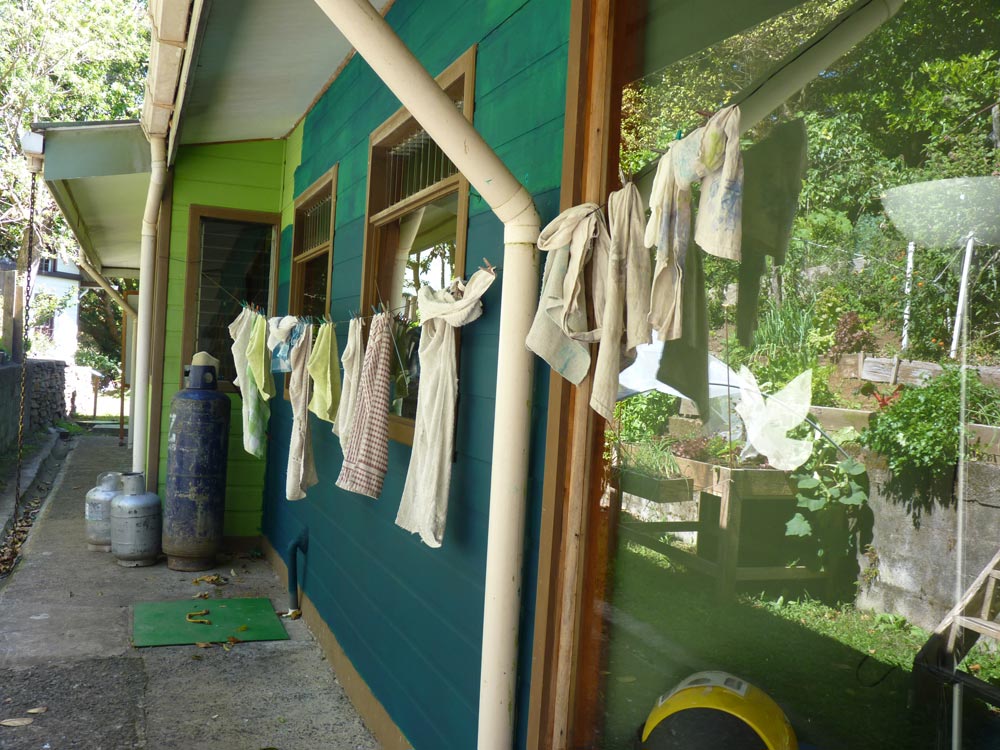
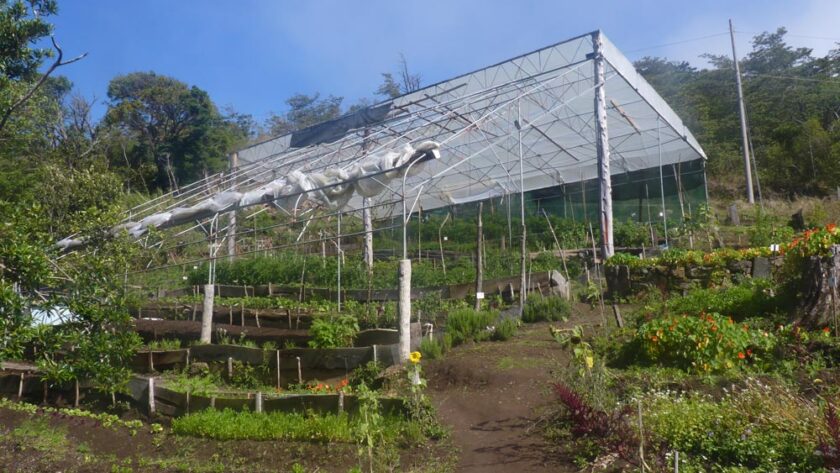



What an inspiring and informative post! I loved reading about the Costa Rican culture and all the things they’ve got so right compared to American culture. And on the flip side of the coin, it evoked feelings of depression and hopelessness in me that I’m enmeshed in that American culture (even despite living on a farm, growing food and medicine for myself and family, etc.) and there are no clear ways out. I am inspired to keep working on what I can, though–I still have a lot of room to streamline, recycle more, declutter, etc.! The hardest part for me is how to build that sense of collectivism and community. I live in a rural area where cars are absolutely the order of the day and zero public transit. And living in the South, public opinion isn’t exactly conducive to making changes to that! I hope we’ll get there someday.
Meredith–I’m totally with you! I try to stay positive for the sake of my own sanity. But I’m not going to lie–when I came back here after 12 days in Costa Rica, it was REALLY hard to adjust. I’m still not fully adjusted, and I’ve been back since the 1st. You are right about there not being any “clear ways out.” But….when I talk with other individuals, more and more people are waking up, wanting to live differently, and I do think things are starting to shift!
My condolences about living in the south. Not that the north is any better these days (such as this: https://druidgarden.wordpress.com/2014/09/02/the-right-to-farm-and-farming-rights-recent-deeply-concerning-developments-in-michigan/)!
Thanks for your comments 🙂
Dana: Thank you for expressing your thoughts on the journey we took. Your words spoke of the feelings that were inside me and grew with each passing day that we were in Costa Rica. This was such a vision quest that I am still having a very hard time processing being back in the United States. We will continue to visit Costa Rica and will
have to plant the seeds of positive change.
Thank you, Dearest Linda! You were an amazing travel partner and I can’t wait to take another trip with you next year :). And we WILL keep planting the seeds of positive change (in soil that has been well prepared and tended :P)
Reblogged this on Blue Dragon Journal and commented:
Costa Rica – an example of a localized, sustainable, happy culture. Can Americans imagine life without WalMart? I can.
Thank you for the reblog Eliza! I would SOOO welcome a life without Walmart, McDonalds, and everything else. It would give local businesses a chance again! 🙂
Not a big traveler, even I have noticed the sameness of American cities and how depressing that seemed. I welcome localization of effort on the part of communities. Over 30 years ago, we were saying, “Act locally, think globally” and now that is slowly coming to past.
I would love to personally invest however I can in “getting the ball rolling” towards the model of Costa Rica 🙂 Living in a condo under the thumb of an extremely restrictive housing association, effectively crushing the hope of growing much of my own food, I figure supporting local farmers is the next best thing. That having been said, I honestly am a little intimidated as where or how to start. As far as I know, most farms don’t exactly have “business hours”, so to speak, where people are welcome to show up and ask about what produce they have available. Is it more standard to call the farm and ask? Go to farmers markets and talk to the different farmers there? Is it considered rude to ask about things like whether their cattle are grass-fed or if they use sustainable growing and land management practices? I feel like I don’t know “the rules” as someone who is willing and interested but with no prior experience. It’s moments like these that make an upbringing of grocery stores feel debilitating..
I lived in a condo for one year. It was my first year in Michigan. It literally crushed my spirit–so I totally know what you are saying :).
I am actually working on a “Farmer’s market” post which I’ll get up before the season starts this year (in Michigan, at least!) It talks about what questions to ask, what to look for, and how to develop relationships with your farmers. The short answer is–talk with them at the farmer’s market. Some of our farmers do regular deliveries even in the off season (yesterday, I picked up onions, potatoes, sausage, and eggs from one farmer who holds an impromptu farmer’s stand every other friday at a Bike shop when our regular market isn’t in season)!
So, yes, glad you need that info, cause its already drafted!~ I’ll prioritize getting that post out for you 🙂
Thank you thank you! 😀
Great article. Costa Rica has just climbed closer to the top of the travel list!! Thanks for writing in such detail. We hear very little about Costa Rica in Australia. 🙂
Fiona, great! I would recommend finding ranches and sustainable farms that also offer B&Bs. Those were really fun to stay at and I got a really great sense of what was going on. One of my favorite of these was a place we stayed in the middle of San Jose called New Earth Spirit Farm. Amazing people, amazing work, 5 min from the airport :). But all over the place you can find places like that to stay, farms to tour, etc! We found a lot of things unexpectedly–I’ll be blogging about one small farm coming up that we literally stumbled upon by accident!
Hello! What a wonderful and informative post. (I don’t travel much either.) I think the ‘seeds of change’ exist and there is a movement toward sustainable living… even if only at a snail’s pace. We are a culture of so much waste! When is enough, enough?? It is refreshing to clear the clutter and live simply. It begins with individuals. Thank you!
Sheepy Hollow – thanks for the comment. I’ve been, for the last two years, decluttering my life. It is SO refreshing. Some things took a while to let go of, but I found really good homes for so much of it (like my old instruments and games to an after-school center that I teach service learning courses at), and so on. And yes, it begins with US! 🙂
What an beautiful and informative post. It’s always inspiring to hear of countries (especially those I haven’t visited) living traditionally with the Earth. This is how it always was, of course, for everyone until the land was taken by stealth: the Industrial Revolution in England driving people to cities; a created potato famine in Ireland to divide and conquer close-knit communities; the Dust Bowl and so on. I’ve been watching the decline of individually owned artisan shops with exciting and intriguing creations in London for 35 years, even in Camden Market; and of old buildings being taken down for eye-torturing glass and concrete structures (factories, offices, flats, no-one can tell the difference). I’ve just spent the weekend in my favourite sacred place: the Neolithic sites of Avebury and stayed at a house with a large garden and hens, alpacas (they keep foxes away from the hens) and its own spring water. Above all, the tranquillity was heavenly. No cars or farm traffic, no planes or chemtrails, no noisy neighbours. Just a thatched cottage in the distance. I always love your blog posts, thank you.
Hi Dawn,
Thank you so much for the comment! I’m so sorry to hear about the decline of the shops in the Camden Market. I’ve been doing some work travel today, and have been thinking about it a lot. It seems easily to blame the corporations for coming in, but really, its up to us to keep our local businesses and local character alive. I’m wondering how to connect with others and encourage that. The one thing I am super happy about though, is the rise of Farmer’s Markets in the US (up to 2000+ from less than 500 10 years ago). So there is some movement here on the local scene!
Awesome post. Thank you very much for sharing this. This is a model which many more places around the world should emulate. Brilliant.
Thank you, Leeby! 🙂
You’re very welcome. Ironically going back to more local communal values — going backwards to go forward — makes so much more sense. Thank you for putting this issue in perspective for my readers!
Yeah, I totally agree. I’ve written a bit about that in this blog before. I’ve also kind of experienced it firsthand–in studying natural building techniques, its amazing how much you depend on the help of others to accomplish anything!
Links in the web of being. Indeed, cooperation is what it’s all about.
Reblogged this on Shamagaia.
I’m so glad you had a chance to visit such a lovely and inspiring place! Happy Alban Eiler. 🙂
Another great thing is that Costa Rica abolished it’s army in the 1950s. Freed up lots of resources. I’m glad you had a great trip. It is an inspiring place.
Yeah, seriously. No military = 60% more resources to go around. That’s an excellent point.
Fascinating! I would love to experience their culture first hand. Great article Dana glad you enjoyed your time there.
Thanks Justin! I’m looking forward to hearing more about your adventures too :). You and Sandra are living it! for real! 🙂
I just started browsing your blog today, and this post reminded me of an article I read earlier: http://www.iflscience.com/environment/costa-rica-has-only-used-renewables-electricity-year. It really is a beautiful country.
Thank you for sharing, Ameila!
Dana, this is such a wonderful and hopeful description of what we all really want! Thanks so much for sharing what you experienced. I sent it along to some Costa Rican friends.
Thank you, Sarah! After some of my recent blog posts mourning the loss of so much, it was refreshing to see what has been preserved by some!
Hi again! It’s Sunday morning in Carriacou Grenada, and I finally have time to read your blog. I searched for ‘tropical’ and found this post. I am eating Soursop, which resembles the Paw Paw in texture and color but is more fibrous and ‘sour’. I eat it for it’s digestive assistance. I am taking the seeds home to USA in hopes of having a Soursop houseplant! It can take months for the seed to germinate, and they have to be very fresh. Soursop leaves steeped in hot water is an excellent sleep aid, but i’ve found it only works well with fresh leaves in a local setting! Next I’ll be looking for fresh Hibiscus leaves to make a tea to treat my consumerist/American induced high blood pressure ; )
Grenada has just been removed from tax haven status, it’s about to accept a huge loan from China to ‘develop’, and it is seemingly losing control of it’s nutmeg industry to Russians who infiltrated some government posts. Grenada seems to be opting for the consumer style of life, hoping to cater to the wealthy luxury tourist. Just how many luxury accommodations does the world require as the money gets sucked into fewer hands?
There is no recycling in Grenada. Unless you count throwing the kitchen scraps out for sheep and goats! They burn garbage in their yards creating air pollution. But here in Carriacou (part of the independent nation of Grenada, Carriacou, and Petit Martinique) a local group of youth built an entire sea worthy catamaran out of plastic sea trash. Local dive shops are systematically hunting down invasive lionfish and turning them into a restaurant entree. And local people are finally rejecting the concrete block house (that signaled status and longevity for a while) for wood houses made of heartwood imported mainly from Guyana. No need to treat that for termites. There are still people building oversize concrete houses here but guess what, they are mostly well off retirees from the USA, coming home with their American consumerist values.
Who will prevail?
It is crucial to get out of USA to get perspective right? The fresh trade winds here make things bettter, as do the oddly shaped local carrots, and the warm people make east coast Americans seem frigid in comparison!
Sorry for the long comment, you have given me a lot of food for thought, thank-you!
Julia, there is much food for thought in your comment, indeed! I’m both heartened and sorry to hear about some of what is happening in Grenada–it seems like this is a pattern of what is happening everywhere, seemingly moving in contradictory directions! But, a committed community can do a lot of good–and I think that gives me hope for the future.